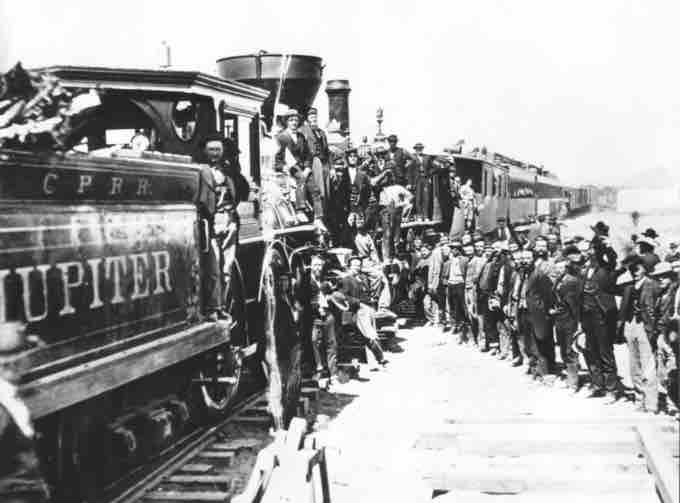The First Transcontinental Railroad was built between 1863 and 1869 to join the eastern and western halves of the United States. Begun right before the American Civil War, its construction was considered to be one of the greatest American technological feats of the nineteenth century. Known as the "Pacific Railroad" when it opened, it served as a vital link for trade, commerce, and travel and opened up vast regions of the North American heartland for settlement. Shipping and commerce could thrive away from navigable watercourses for the first time since the beginning of the nation. Much of this line is still used by the California Zephyr, although some parts were rerouted or abandoned.
The construction of the railroad resulted in the end of most of the far slower and more hazardous stagecoach lines and wagon trains. The railroad also led to a great decline of traffic on the Oregon and California Trail, which had helped populate much of the West. The Transcontinental Railroad provided much faster, safer, and cheaper transportation for people and goods across the western two-thirds of the continent. It took one week to travel from Omaha to San Francisco via emigrant sleeping car at a fare of about $65 for an adult. The sale of land grants and the transport provided for timber and crops led to the rapid settling of the "Great American Desert."
Labor
Many army veterans and Irish emigrants were the main workers on the Union Pacific, while most of the engineers were ex-army men who had learned their trade keeping the trains running during the American Civil War. The Central Pacific Railroad, facing a labor shortage in the more sparsely settled West, relied on Chinese laborers who did prodigious work building the line over and through the Sierra Nevada mountains and then across Nevada to northern Utah. The Chinese were commonly referred to at the time as "Celestials" and China as the "Celestial Kingdom." Labor-saving devices in those days consisted primarily of wheelbarrows, horse- or mule-pulled carts, and a few railroad-pulled gondolas. The construction work involved an immense amount of manual labor. Initially, Central Pacific had a hard time hiring and keeping unskilled workers on its line, as many would leave for the prospect of far more lucrative gold or silver mining options elsewhere. Most of these Chinese workers were represented by a Chinese "boss" who acted as a translator, collected salaries for his crew, enforced discipline, and relayed orders from an American general supervisor. Most Chinese workers spoke only rudimentary or no English, and the supervisors typically only learned rudimentary Chinese. Most of the men received between $1 and $3 per day, the same as unskilled white workers; but the workers imported directly from China sometimes received less.
Building the Railroad
The track laying was divided up into various parts. In advance of the track layers, surveyors consulting with engineers determined where the track would go. Workers then built and prepared the roadbed; dug or blasted through hills; filled in washes; built trestles, bridges, or culverts across streams or valleys; made tunnels if needed; and laid the ties. The actual track-laying gang would then lay rails on the previously laid ties positioned on the roadbed, drive the spikes, and bolt the fishplate bars to each rail. At the same time, another gang would distribute telegraph poles and wire along the grade, while the cooks prepared dinner and the clerks busied themselves with accounts and records, using the telegraph line to relay requests for more materials and supplies or to communicate with supervisors. Usually the workers lived in camps built near their work site.
Tunnels were blasted through hard rock by drilling holes in the rock face by hand and filling them with black powder. Sometimes cracks were found which could be filled with powder and blasted open. The loosened rock would be collected and hauled out of the tunnel for use in a fill area or as roadbed, or else dumped over the side as waste. A foot or so advance on a tunnel face was a typical day's work. Some tunnels took almost a year to finish; the Summit Tunnel, the longest, took almost two years. In the final days of working in the Sierras, the recently invented nitroglycerin explosive was introduced and used on the last tunnels including Summit Tunnel.

Finishing the First Transcontinental Railroad
Workers celebrating the completion of the First Transcontinental Railroad on May 10, 1869.